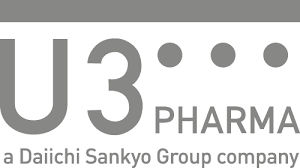预约演示
更新于:2025-05-07

U3 Pharma AG
更新于:2025-05-07
概览
关联
1
项与 U3 Pharma AG 相关的药物靶点 |
作用机制 HBEGF抑制剂 |
在研机构- |
原研机构 |
在研适应症- |
最高研发阶段终止 |
首次获批国家/地区- |
首次获批日期- |
100 项与 U3 Pharma AG 相关的临床结果
登录后查看更多信息
0 项与 U3 Pharma AG 相关的专利(医药)
登录后查看更多信息
9
项与 U3 Pharma AG 相关的文献(医药)2016-05-20·Journal of Clinical Oncology
A phase I, open label, two part, safety and tolerability study of U3-1784 in patients with advanced solid tumours.
作者: Martinez, Alberto ; Ciprotti, Marika ; Jansen, Mendel ; Hanai, Masaharu ; Tokuhiro, Shinya ; Shuster, Dale Edward ; Abraham, Reimar ; Oitate, Masataka
2012-04-15·Cancer Research
Abstract 2519: U3-1565, a fully human anti-HB-EGF monoclonal antibody, inhibits oncogenic signaling and tumor cell growth in vitro and in vivo
作者: Schramm, Julia ; Wagner, Tanja ; Pfeil, Ines ; Riffner, Yvonne ; aus dem Siepen, Patricia ; Zwick-Wallasch, Esther ; Hettmann, Thore
2011-11-12·Molecular Cancer Therapeutics
Abstract A182: U3–1287 (AMG 888), a fully human anti-HER3 mAb, demonstrates in vitro and in vivo efficacy in the FaDu model of human squamous cell carcinoma of the head and neck (SCCHN).
作者: Freeman, Daniel J. ; Bready, James ; Hettmann, Thore ; Ogbagabriel, Selam ; Radinsky, Robert ; Sun, Ji-Rong
1
项与 U3 Pharma AG 相关的新闻(医药)2014-09-29
September 29, 2014
By
Mark Terry
, BioSpace.com Breaking News Staff
Daiichi Sankyo
and
Ambit Biosciences
announced
today they will merge in a deal valued up to $410 million.
Daiichi will acquire all outstanding Ambit stock for $15 per share, about $315 million, and merge with a Daiichi subsidiary. Ambit stockholders will potentially
receive
additional cash payments if sales milestones are met, which would bring the entire deal to $410 million.
San Diego-based Ambit Biosciences focuses on unmet medical needs in oncology, autoimmune and inflammatory diseases by inhibiting kinases that are significant drivers for those illnesses. The company’s pipeline includes three programs: quirzartinib for acute myeloid leukemia (AML); AC410, a small molecule inhibitor of JAK2, with possible utility for autoimmune and inflammatory diseases; and AC708, a small molecule compound that inhibits CSF1R, a receptor tyrosine kinase. Quirzartinib was entered into a
phase 3 clinical trial
in April 2014.
“Daiichi Sankyo is the ideal organization to take quizartinib to the next stage of development, and ultimately, to achieve our goal of making it available as quickly as possible to help as many AML patients as possible,” said
Michael Martino
, Ambit president and chief executive officer, in a statement. “This attractive offer to shareholders is a testament to the hard work and dedication of the Ambit team to our mission of developing innovative therapies for areas of high unmet medical need.”
Tokyo-based Daiichi maintains a portfolio of marketed drugs for hypertension, hyperlipidemia, and bacterial infections, and is also developing treatments for blood clotting disorders. The company is also pushing an R&D program into oncology and cardiovascular-metabolic therapies.
The company
announced
on Sept. 26 that it had received approval from the Japanese Ministry of Health, Labour and Welfare for LIXIANA (edoxaban tosilate hydrate) for the prevention of ischemic stroke and systemic embolism in patients with non-valvular atrial fibrillation (NVAF) and for the treatment and prevention of venous thromboembolism (VTE). The company has also filed for approval of the drug in both the U.S. and European Union.
“The acquisition of Ambit Biosciences further builds our presence in oncology to ensure we are delivering on our goal of providing world-class, innovative pharmaceuticals in core areas of unmet medical need,” said
Joji Nakayama
, Daiichi president and chief executive officer, in a statement. “Long-term success in oncology depends upon three pillars: fostering development of our in-house molecules, exploring mutually beneficial partnerships and executing strategic purchases, such as Ambit Biosciences, which follows our acquisitions of U3 Pharma and Plexxikon.”
var switchTo5x=true;
stLight.options({publisher: "0341611e-38a4-415d-9e18-75e093ff27e0", doNotHash: false, doNotCopy: false, hashAddressBar: false});
并购上市批准临床3期
100 项与 U3 Pharma AG 相关的药物交易
登录后查看更多信息
100 项与 U3 Pharma AG 相关的转化医学
登录后查看更多信息
组织架构
使用我们的机构树数据加速您的研究。
登录
或

管线布局
2026年01月01日管线快照
管线布局中药物为当前组织机构及其子机构作为药物机构进行统计,早期临床1期并入临床1期,临床1/2期并入临床2期,临床2/3期并入临床3期
其他
1
登录后查看更多信息
当前项目
| 药物(靶点) | 适应症 | 全球最高研发状态 |
|---|---|---|
Anti-HB-EGF antibody(U3 Pharma) ( HBEGF ) | 结直肠癌 更多 | 终止 |
登录后查看更多信息
药物交易
使用我们的药物交易数据加速您的研究。
登录
或

转化医学
使用我们的转化医学数据加速您的研究。
登录
或

营收
使用 Synapse 探索超过 36 万个组织的财务状况。
登录
或

科研基金(NIH)
访问超过 200 万项资助和基金信息,以提升您的研究之旅。
登录
或

投资
深入了解从初创企业到成熟企业的最新公司投资动态。
登录
或

融资
发掘融资趋势以验证和推进您的投资机会。
登录
或

生物医药百科问答
全新生物医药AI Agent 覆盖科研全链路,让突破性发现快人一步
立即开始免费试用!
智慧芽新药情报库是智慧芽专为生命科学人士构建的基于AI的创新药情报平台,助您全方位提升您的研发与决策效率。
立即开始数据试用!
智慧芽新药库数据也通过智慧芽数据服务平台,以API或者数据包形式对外开放,助您更加充分利用智慧芽新药情报信息。
生物序列数据库
生物药研发创新
免费使用
化学结构数据库
小分子化药研发创新
免费使用